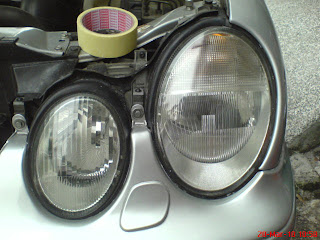

It's being reported today that Mercedes is dropping their Sensotronic Brake Control (SBC) from some of their models, starting with the E-Class.
The SBC system has been a chronic thorn in Mercedes' side. Manufactured by the Robert Bosch Group, the SBC system has led to the recall of over
2 million Mercedes models (
namely the E-Class), and has played an integral part in the widespread "Mercedes quality problems" you hear about so often.
So what exactly is the SBC Braking system?The SBC braking system uses a microcomputer to monitor the car and driver actions. In the event it's needed, such as emergency braking, the system monitors brake pressure, and applies the appropriate stopping power necessary, even if the driver doesn't exert enough power.
SBC features a host of other features as well, including distributing brake force to different wheels during cornering, to ensure greater stability in the vehicle as well as maximum stopping power; the SBC system even dries the brake discs if a film of water forms on them.
In other words, the system sounds like a milestone achievement in braking technology, and it would be, assuming it worked properly. Unfortunately, although the intent was good, the execution was not.
As you can probably tell, the entire system relied on electronics, and as I'm sure everyone can attest to, nothing is more prone to malfunctioning than electronics. And that is exactly what happened. Before long, wiring in the SBC braking system deteriorated, and suddenly the SBC system no longer functioned.
Of course, Mercedes had a backup hydraulic-only braking system in place, but the feeling of suddenly not having the same stopping power was enough to send Mercedes' owners everywhere heading for the hills - and we haven't stopped hearing about Mercedes' quality problems since.
http://www.youtube.com/watch?v=PpvCoaRoQa4Advantages of SBC:
-Emergency braking: stopping distance reduced by up to three per cent
-Driving stability: precise braking impulses for perfect ESP® performance
-Braking in corners: greater safety thanks to variable brake force distribution
-Comfort: no pedal vibrations during ABS opereration
Disadvantages of SBC:
-Maintenance is high, electronics parts are costly to replace,eg: SBC hydraulic unit has operating hour, when the service threshold is reached the unit has to be replaced.
-Some people don’t like the noise from SBC hydraulic unit(motor build in)
Apparently, Mercedes is finally getting tired of trying to convince consumers of the benefits of the SBC system. Although the system is, in my opinion, a definite advancement in braking technology, poor implementation and poor design are ultimately leading to its downfall.
That's not to say Mercedes will entirely scrap the SBC system. I'm sure Mercedes will continue to develop and improve the braking system in the future; I just have a feeling the next generation of SBC will be slightly less prone to malfunctioning.
In the end
they decided to drop SBC and substitute it with ABR(adaptive brake) new brake system. ABR available on W211 facelift models. from the pictures above the top one is facelifted model and the first model at below.









